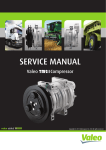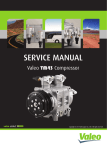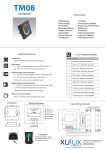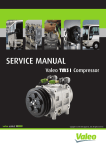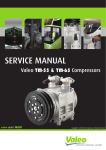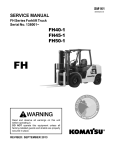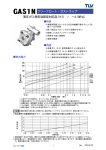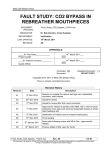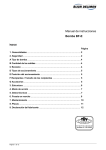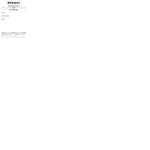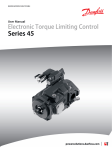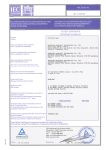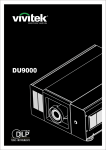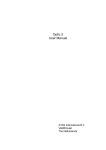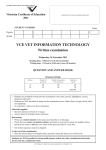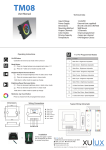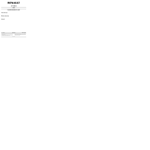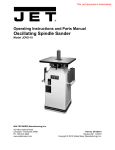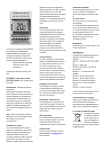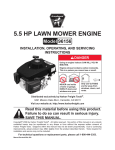Download here - Valeo Compressors
Transcript
SERVICEMANUAL
ValeoTM08, TM13, TM15& TM16Compressors
Copyright © 2015 Valeo Japan CO., LTD. All rights reserved.
Foreword
This service manual has been elaborated to help service personnel to provide efficient and correct service
and maintenance on the TM08, TM13, TM15 & TM16
model compressors (for HFC-134a) for automotive air
conditioning.
The contents of this manual, including illustrations,
drawings and specifications were the latest available
at the time of printing.
Valeo Japan reserves the right to make changes in
specifications and procedures at any time without
notice.
This manual includes the operation specifications,
procedures for disassembly, reassembly and
inspection of the compressor.
VALEO JAPAN CO., LTD.
WARNINGS
The following warning signs are used in this service manual.
These are extremely important to ensure safe operation and to prevent body injuries and
property damage.
They must be fully understood before starting the air conditioner maintenance.
WARNING!
Maintenance must be properly done to avoid serious injury risks.
CAUTION!
Improper maintenance can result in injury or property damage.
MEANING OF MARKS
The following marks are used in this service manual to facilitate correct air conditioner
maintenance.
Advice
Procedures necessary to ensure the best air conditioner maintenance.
Note
Information to optimize the air conditioner maintenance.
-1-
Contents
1-Product description................................................................................... 3
2-Operation precautions.............................................................................. 18
3-Handling instructions................................................................................ 19
Maintenance precautions............................................................................. 19
Work area............................................................................................... 19
Refrigerant handling.................................................................................. 19
Compressor handling.................................................................................. 20
Compressor removal................................................................................... 20
Oil return operation.................................................................................... 21
Oil handling............................................................................................... 21
Oil contamination....................................................................................... 22
Oil check.................................................................................................... 22
Replacement of components......................................................................... 23
Running-in operation................................................................................... 24
Compressor runnning-in............................................................................... 24
Magnetic clutch running-in........................................................................... 24
Leak test.................................................................................................... 25
Storing a repaired compressor ....................................................................... 25
Refrigerant charging................................................................................... 26
Installation position..................................................................................... 27
Installation precautions................................................................................ 27
Piping precautions....................................................................................... 28
4-Troubleshooting ........................................................................................ 29
Compressor troubleshooting ........................................................................ 29
Compressor troubleshooting tree .................................................................. 29
A/C cycle diagnosis by gauge pressure........................................................... 33
5-Tightening torques.................................................................................... 35
6-Service procedures - Magnetic clutch..................................................... 36
7-Services procedures - Shaft seal assembly.............................................. 40
8-Services procedures - Cylinder heads...................................................... 43
9-Service tools.............................................................................................. 47
Magnetic clutch service tools........................................................................ 47
Compressor tools....................................................................................... 48
Test and inspection tools ............................................................................. 48
-2-
1-Product description - Compressor
Compressors
TM08
MODEL
TM13
TECHNOLOGY
TM15
TM16
Heavy Duty Swash Plate
DISPLACEMENT
82cc / 5 in3 per rev.
NUMBER OF CYLINDERS
131cc / 8 in3 per rev. 147cc / 9 in3 per rev. 163cc / 10 in3 per rev.
6 (3 double-headed pistons)
REVOLUTION RANGE
700-6000 rpm
DIRECTION OF ROTATION
Clockwise & Counter clockwise (depending on clutch type)
BORE
36 mm (1.42 in)
13.4 mm
(0.53 in)
STROKE
21.4 mm
(0.84 in)
SHAFT SEAL
24.0 mm
(0.94 in)
26.7 mm
(1.05 in)
Lip seal type
LUBRICATION SYSTEM
Splash lubrication
REFRIGERANT
HFC-134a
ZXL 100PG PAG OIL (150 cc/9.1 in3)
OIL (QUANTITY)
WEIGHT (w/o clutch)
DIMENSIONS (w/o clutch)
Length - Width - Height
MOUNTING
ZXL 100PG PAG OIL
(180 cc/11.03 in3)
4.1kg / 9.0 lbs
4.4kg / 9.7 lbs
4.6kg / 10.2 lbs
4.9kg / 10.8 lbs
168-124-145 (mm)
6.6-4.9-5.7 (in)
192-124-142 (mm)
7.6-4.9-5.6 (in)
202-124-142 (mm)
8.0-4.9-5.6 (in)
207-124-142 (mm)
8.1-4.9-5.6 (in)
Direct (side) & Ear Mount
Alternator/Ear mount
Saturatedcondensingconditions
Valeo TM08, TM13, TM15 & TM16 Application limits for HFC-134a
PSIA
PSIG
oF
MPaA
MPaG
oC
314
299
160
2.17
2.06
71
191
177
122
1.32
1.22
50
100
85
79
0.69
0.58
26
tc
te
tc : Condensing temperature
te : Evaporating gas temperature
-10
14
oC
0.10
0.37
MPaG
0.20
047
MPaA
14
57
oF
14
54
PSIG
29
69
PSIA
Saturatedevaporatingconditions
-3-
1-Product description - Magnetic clutch
Magnetic clutch
VALEO TM08, TM13, TM15 & TM16 are available either as a compressor and magnetic clutch assembly or as a
compressor body that customers can fit with compatible magnetic clutches. The magnetic clutch design Valeo
has been promoting for more than 20 years is now gradually adopted by other major market actors.
Our compressors and magnetic clutches have successfully passed the thousand hours of long validation tests
in Valeo Compressors research center laboratory. Operational excellence was demonstrated during hot season
testing on field under challenging climates in the most stressful conditions.
Being able to rely on our robust magnetic clutch provides the best way to reduce fuel consumption without
using additional unloading devices that decrease significantly the efficiency and durability of the compressor.
The range of Valeo magnetic clutches ensures an unmatched reliability and the longest durability that perfectly
matches the Valeo TM08, TM13, TM15 & TM16 compressor qualities.
Specifications TM08, TM13, TM15 & TM16*
TYPE
Electromagnetic single-plate dry clutch
RATED VOLTAGE
12 VDC & 24 VDC
POWER CONSUMPTION
49 W maximum
STATIC TORQUE
49 N·m {36 lb·ft}
DIRECTION OF ROTATION
Clockwise & Counter clockwise (depending on clutch)
WEIGHT
Approx 2.2 kg {4.9 lbs}
V-BELT TYPE
V-groove (A or B) or V-ribbed (PK)
*The specifications may vary with the compressor.
Please also note that the maintenance procedures introduced in this service manual apply only to magnetic
clutches provided by Valeo.
-4-
1-Product description - Name Plate
Name plate
To ensure that the compressor operates smoothly,
respect carefully the indications written on the
name plate.
Name plate
Tip
COMP. TYPE
PART NO.
SERIAL NO.
OIL
LEAK. TEST
REF.
As TM13, TM15 & TM16 compressors have almost the same dimensions, the best way to
differentiate them quickly is by referring to the
name plate.
TM-XX
TMXX
ZXXXXXXX
X X X X X X XX X
XX
XX
XX
XX
XX
XX
XX
XX
XX
X
X
3 3
ZXL
ZXL100PG
100PG1500
XXXcmcm
HIGH SIDE
LOW SIDE
2.9MPaG
1.5MPaG
HFC-134a MADE IN JAPAN
HFC-134a
-5-
1-Product description - Dimensions TM08
( 183.3 )
89
11
±0.1
Ø 120
Ø 135
±0.1
16
36.6
±0.6
61.6
67
5
±0.1
14 °
14 °
3/4-16UNF
DISCHARGE
104
±0.3
80
( 139.6 )
7/8-14UNF
SUCTION
5.5
8- Ø 10.3
104
±0.3
-6-
+0.4
1-Product description - Dimensions TM13
( 208 )
98
12.4
±0.1
Ø135
Ø120
±0.1
16
±0.6
69.2
73.3
±0.1
28.5
21.5
3/4-16UNF
DISCHARGE
80
7/8-14UNF
SUCTION
D
S
104
±0.3
142
44.2
104
8- Ø10.3
±0.3
-7-
+0.4
1-Product description - Dimensions TM15
( 215.8 )
112
+0.05
-0.15
Ø 135
Ø 120
14.35
±0.1
16
±0.6
64.6
83.3
+0.2
21.5
28.5
80
7/8-14UNF
SUCTION
3/4-16UNF
DISCHARGE
D
S
104
±0.3
142
39.6
8- Ø 10.3
104
±0.3
-8-
+0.4
1-Product description - Dimensions TM16
( 222.8 )
112
+0.05
-0.15
Ø 135
Ø 120
14.35
±0.1
16
±0.6
64.6
80
7/8-14UNF
SUCTION
+0.2
83.3
28.5
21.5
3/4-16UNF
DISCHARGE
D
S
104
±0.3
142
39.6
8- Ø 10.3
104
±0.3
-9-
+0.4
1-Product description - Exploded view
7
6
5
19
3
27
4
25
24
17
23
22
21
2
1
20
18
8
9
10
11
16
15
14
13
12
16. Sunction valve
17. Pin
18.Cylinder shaft assembly
19.Oil filler plug
20.Sunction valve
21.Valve plate assy 22.Gasket
23.O-ring
24.Rear Cylinder Head
25.O-ring
26.Relief Valve
27.Oil drain plug
1. Center bolt
2. Armature assembly
3. Adjusting shim
4. Snap ring
5. Pulley assembly
6. Screw
7. Field coil
8. Bolt
9. Gasket
10.Snap ring
11.Shaft seal assembly
12.Front cylinder head
13.O-ring
14.Gasket
15.Valve plate assy -10-
26
1-Product description - Performance TM08
The performance data below were measured under the following conditions:
• Discharge Pressure: Pd = 1.52 MPaG
• Suction Pressure: Ps = 0.18 MPaG
• Subcooling temperature: SC = 5°C
• Super heat temperature: SH = 10°C
Valeo TM08 performance data table (R134a)
TM08
Nc (r/min)
1200
1800
2400
3000
Vol. Eff. (%)
60.0
58.8
58.7
59.1
Capacity (kW)
1.57
2.31
3.08
3.87
Power (kW)
0.82
1.27
1.75
2.30
COP
1.93
1.82
1.76
1.69
Volumetric Efficiency (%)
Cooling Capacity (kW) / Power (kW) / COP
Valeo TM08 performance data graph (R134a)
Compressor Speed (rpm)
-11-
1-Product description - Performance TM13
The performance data below were measured under the following conditions:
• Discharge Pressure: Pd = 1.52 MPaG
• Suction Pressure: Ps = 0.18 MPaG
• Subcooling temperature: SC = 5°C
• Super heat temperature: SH = 10°C
Valeo TM13 performance data table (R134a)
TM13
Nc (r/min)
800
1200
1800
2400
3000
Vol. Eff. (%)
58.3
63.0
65.7
63.7
61.1
Capacity (kW)
1.64
2.64
4.13
5.35
6.41
Power (kW)
0.92
1.41
2.22
3.04
3.93
COP
1.78
1.87
1.86
1.76
1.63
Volumetric Efficiency (%)
Cooling Capacity (kW) / Power (kW) / COP
Valeo TM13 performance data graph (R134a)
Compressor Speed (rpm)
-12-
1-Product description - Performance TM15
The performance data below were measured under the following conditions:
• Discharge Pressure: Pd = 1.52 MPaG
• Suction Pressure: Ps = 0.18 MPaG
• Subcooling temperature: SC = 5°C
• Super heat temperature: SH = 10°C
Valeo TM15 performance data table (R134a)
TM15
Nc (r/min)
800
1200
1800
2400
3000
Vol. Eff. (%)
57.5
63.3
66.2
64.1
61.4
Capacity (kW)
1.81
2.98
4.65
6.03
7.24
Power (kW)
1.04
1.57
2.50
3.45
4.42
COP
1.73
1.90
1.86
1.75
1.64
Volumetric Efficiency (%)
Cooling Capacity (kW) / Power (kW) / COP
Valeo TM15 performance data graph (R134a)
Compressor Speed (rpm)
-13-
1-Product description - Performance TM16
The performance data below were measured under the following conditions:
• Discharge Pressure: Pd = 1.52 MPaG
• Suction Pressure: Ps = 0.18 MPaG
• Subcooling temperature: SC = 5°C
• Super heat temperature: SH = 10°C
Valeo TM16 performance data table (R134a)
Nc (r/min)
800
1200
1800
2400
3000
Vol. Eff. (%)
64.9
67.6
65.5
62.9
59.3
2.26
3.53
5.12
6.57
7.74
Power (kW)
1.15
1.78
2.78
3.88
4.90
COP
1.97
1.99
1.84
1.69
1.58
TM16 Capacity (kW)
Volumetric Efficiency (%)
Cooling Capacity (kW) / Power (kW) / COP
Valeo TM16 performance data graph (R134a)
Compressor Speed (rpm)
-14-
1-Product description - Swash plate system
Valeo TM08, TM13, TM15 & TM16 are 6 cylinder
swash plate type compressors. With this type of
compressor, the cylinders and pistons are arranged
axially along the drive shaft.
The pistons operate within the cylinders and
are driven by a swash plate to perform suction,
compression and discharge.
Drive shaft
Radial bearing
Swash plate system
The drive shaft, which is driven by the engine
through the magnetic clutch, is equipped with a
swash plate.
The drive shaft is supported by two radial bearings
and two thrust bearings.
The swash plate is rotated by the drive shaft, and
moves the pistons back and forth.
Thrust bearings
Suction
Compression
Shoe
Radial bearing
The pistons in the cylinders are mounted on the
swash plate through hemispherical shoes.
Each piston has a compression head at each end. The
rotation of the swash plate results in a reciprocating
piston movement horizontal to the drive shaft.
The cylinders, which are arranged at 120° intervals
around the drive shaft, are each divided into 2
chambers providing 3 front and 3 rear bores.
As each piston performs suction and compression at
either end, the compressor operates as a 6 cylinder
compressor.
Thrust bearing
Compression
Piston
Piston Drive System
Radial bearing
Suction
Swash plate
Piston
-15-
1-Product description - General
Fullchargeofcompressoroil
TMXX
COMP. TYPE
PART NO.
SERIAL NO.
OIL
XXXXXXXX X
XXXXXXXXXX
ZXL 100PG XXX cm3
LEAK. TEST
HIGH SIDE
LOW SIDE
2.9MPaG
1.5MPaG
REF.
HFC-134a MADE IN JAPAN
Each compressor is delivered filled with a specified
quantity of compressor oil as described on its label.
The total amount of oil your air conditioning system
requires is provided by the system designer or
supplier.
Compressor
1. The direction of rotation is clockwise or counter
clockwise (depending on clutch type).
Operation condition table
Item
Condition
Surrounding
Under 120°C (248°F)
temperature
Minimum: 700 r/min
Speed
Maximum: 6000 r/min
Continuous: 6000 r/min
Maximum: 2.07 MPaG
Pressure
{22.1kgf/cm², 299psig}
45˚
2. The compressor must be operated under the
conditions shown in the operation condition
table shown at left.
CAUTION!
The A/C cycle components must be
designedsothatthepressureinthecycle
doesnotexceed2.07MPaG{21.4kgf/cm2,
299psig}
4. Inclination limit at installation
The compressor must be installed on the vehicle
within the range shown at left.
45˚
10˚
10˚
-16-
1-Product description - General
Compressorbracket
1. Install the bracket securely on the chassis frame
or engine body. As the engine vibrations may be
severe, the bracket and mounting bolts must be
installed securely.
2. Vibration resistance
There must not be any resonance under 250 HZ.
Magneticclutch
1. Voltage
DC24V
The terminal voltage of the magnetic clutch
must exceed 21 V.
DC12V
The terminal voltage of the magnetic clutch
must exceed 10.5 V.
1 mm
Magnetic clutch
Idle pulley
2. Ratio of magnetic clutch to drive pulley
• When the compressor is driven from the pulley
drive of the vehicle, the magnetic clutch to drive
pulley ratio should avoid the range 1: 0.92-1.08
to limit vibration and resonance.
• The compressor speed must not exceed the
specified speed.
CAUTION!
Pulley ratio is the ratio of the magnetic
clutchdiametertothedrivepulleydiameter.
Drive pulley
3. Pulley alignment tolerance is less than 1mm
(0.04 in).
4. Pulley groove: V-groove or V-ribbed.
5. The Belt tension must be adjusted to the tension
specified by the belt maker.
-17-
2-Operation precautions
1. During the off season of the air conditioner,
operate the compressor for a few minutes once
a week.
2. Do not drive through water. Water may damage
the magnetic clutch, thus preventing normal
operation.
3. Do not allow a compressor that has not been
used for a long period to become wet.
4. Always charge the A/C system with the specified
quantity of refrigerant.
5. Keep the compressor clear of water projection
while cleaning the vehicule.
-18-
3-Handling instructions
Maintenance precautions
Work area
As the components of air conditioners are particularly
sensitive to moisture, dirt and rust, always observe
the following:
• Work indoors whenever possible
• Select a flat ground work area
• Keep the work area clean
• Select a work area with adequate ventilation.
CAUTION!
Refrigerant itself is not harmful, but
excessive accumulation in a closed area can
cause oxygen deficiency.
Gasoline
Avoid inflammables
• Keep open flame and inflammables away from
the vehicle in which the air conditioner is being
installed.
(Fire is particularly dangerous during the gas
leak inspection following installation)
WARNING!
Contact with flame and high temperatures
can generate toxic gases.
Safety glasses
Gloves
Refrigerant handling
WARNING!
Direct contact with refrigerant can cause
frostbite or blindness.
Always wear safety glasses and protective
gloves.
Do not work with refrigerant close to your
face.
1. Do not misidentify refrigerants
If an HFC-134a air conditioning system is mistakenly
charged with another refrigerant, serious problems
such as compressor seizing may occur. Therefore,
confirm before charging with refrigerant that the
type of air conditioning system is an HFC-134a
system.
-19-
3-Handling instruction
Do not release refrigerant into
the air
FILL
AUTO
2. Do not release refrigerant into the air
Although HFC-134a is not subject to CFC regulations,
it can have effect on global warming and so should
not be released into the air. When removing
refrigerant from the air conditioner system, always
use a refrigerant recovery unit made especially for
HFC-134a.
Recovery unit
Compressor handling
Do not strike or unecessarily turn the compressor
upside down. If the compressor is knocked over or
turned upside down during handling or installation,
rotate the armature plate 5 or 6 times by hand to
circulate the oil.
Otherwise, oil in the cylinder during compressor
start-up will cause valve damage and reduce
durability.
Oil return operation
Refrigrant recovery
Compressor removal
Oil inspection
Compressor removal
When the compressor is operational
1. Perform the oil return operation (see p.21).
2. Recover the refrigerant from the system using a
refrigerant recovery unit.
3. Remove the compressor.
4. Drain the oil from the compressor and close all
open connections immediately.
5. Check the oil quantity and the degree of
contamination (see p.21).
When the compressor is inoperable
1. Recover the refrigerant from the system using
a refrigerant recovery unit if the shut-off valves
are removed with the compressor.
2. Remove the compressor.
3. Drain the oil from the compressor and close all
open connections immediately.
4. Check the oil quantity and the degree of
contamination (see p.22).
-20-
3-Handling instructions
Oil return operation
Compressor oil mixed with refrigerant is circulating
in the air conditioning system.
Perform the oil return operation to return this oil to
the compressor before removing components from
the system.
1. Open the doors and windows and operate the
blower motor at maximum speed.
2. Operate the vehicle engine at idling during at
least 20 minutes.
Note: The maximum amount of oil cannot be
recovered at higher speeds. This operation also
requires a warm ambient temperature.
Oil handling
Oil specification
Use only ZXL 100PG PAG (DH-PS).
Oil quantity inspection
There is no particular need for frequent inspection or
replacement, although it is recommended to check
operating refrigerent pressures and oil levels at the
start of the season.
Please replace the refrigerant and restore the system
oil and refrigerant charge to factory specifications if:
• the AC system is opened for repair or replacement
of any component (e.g.: evaporator, condenser
or receiver drier)
• any loss of charge - refrigerant or oil - is detected.
Handling precautions
Do not mix with other oils
1. The oil must be free from dust, metal filings, etc.
2. Do not mix oils.
3. The moisture content must not exceed 1,000
ppm. (PAG oil only)
4. The oil easily absorbs moisture when the
container is open. Therefore always seal the
container immediately after use. (PAG oil only)
Cap the container immediately
-21-
3-Handling instructions
Oil contamination
Opacity
Color change
Foreign substances
Metal filings
Unlike engine oil, no cleaning agent is added to
the compressor oil. Even if the compressor is run
for a long period (approximately 1 season), the
oil never becomes turbid as long as there is nothing wrong with the compressor or its method of
use. Inspect the extracted oil for any of the following.
• Increased opacity of the oil.
• Color change to red.
• Presence of foreign matter, metal filings, etc.
WARNING!
When system (oil) contamination is
found during compressor replacement,
flush the A/C system with a fluid that
meets SAE J2670 and replace the drier (or
accumulator).
Oil check
The compressor oil must be checked as follows
when being charged into a used system.
1. Perform the oil return operation (see p.21).
2. Remove the compressor from the vehicle.
3. Remove the oil filler plug and drain the oil
through the oil filler plug and the high and
low pressure connectors.
4. Check the oil for contamination.
5. Fill the compressor with the specified
amount of oil (see p.23) through the suction
port or the oil filler plug in case of TM16.
Charge specified quantity of
compressor oil
-22-
3-Handling instructions
Current
Compressor
is kept
Compressor
is replaced
Amount
recovered
Charging
amount
Amount
to remove
from new
compressor
90
or more
Same as
recovered
60
under
90
90
45
108
or more
Same as
recovered
72
Under
108
108
54
unit: cm3 & cc
Factory
oil
charge
TM08
TM13
TM15
150
TM16
180
Current
Compressor
is kept
Compressor
is replaced
Amount
recovered
Charging
amount
Amount
to remove
from new
compressor
5.5
or more
Same as
recovered
3.7
Under
5.5
5.5
2.7
6.6
or more
Same as
recovered
4.4
Under
6.6
6.6
3.3
unit: cu in
Factory
oil
charge
TM08
TM13
TM15
TM16
9.2
11.0
CAUTION!
The specified oil quantity differs, depending
on the type of air conditioner system. A
label describing the specified quantity is
attached to the compressor.
Additionally, all of the oil cannot be removed
when draining the compressor as some
remains as an oil film on the inside of the
compressor and the system components.
Therefore, refer to the table at left when
recharging the compressor with oil. Excess
oil adversely affects the cooling capacity
and the compressor.
6. Install the oil filler plug and tighten it to the
specified torque.
Specified torque: 13 ~ 15 N·m
{1.3 ~ 1.5 kgf·m, 9.4 ~ 10.2 lbf·ft}
CAUTION!
The oil filler plug O-ring must be replaced
with a new one.
Replacement of components
50cm3 (3 cu in)
When replacing the system’s component parts,
supply the following amount of oil to the compressor.
10cm3 (0.6 cu in)
Component mounted
Amount of oil
Evaporator
50 cm3 (3 cu in)
Condenser
30 cm3 (1.8 cu in)
Receiver drier
10 cm3 (0.6 cu in)
After installing these component parts, check
the compressor oil. Refer to page 22.
30cm3 (1.8cu in)
-23-
3-Handling instructions
Running-in operation
Flexible hose
Whenever moving parts have been replaced, it is
necessary to run-in both the compressor and the
magnetic clutch.
Compressor running-in
Reassembled compressors must be run-in after
the leak test (see next page).
1. Check that the compressor contains the
specified amount of oil.
2. Interconnect the suction fitting and the discharge fitting with the flexible hose.
3. Connect the two connector ports using a
flexible hose
4. Run the compressor at 500r/min for 30 minutes to 60 minutes. This operation may be
performed by an electric motor or the engine
of an automobile.
5. Replace the oil.
6. Repeat the leak test.
CAUTION!
While the compressor is being run-in in step
3 above, check the outside temperature of
the front head. If the temperature exceeds
80°C (176°F), stop the running-in operation.
Resume the operation when the head has
cooled.
Magnetic clutch running-in
High pressure connector
Low pressure connector
1. Install the clutch on the compressor.
2. Install the compressor on the test bench,
and operate the compressor by running the
system.
3. Maintain the compressor speed at 500 rpm.
Operate the A/C switch through the ON/OFF
cycle at least 50 times (“ON” for 10 seconds
and “OFF”for 10 seconds).
ON
OFF
(50 times)
-24-
3-Handling instructions
Leak test
Valve assembly
(597017-1120)
The compressor must be checked for refrigerant
leaks after it is repaired. The procedure is as follows.
1. Using the valve assembly (597017-1120), fill the compressor with refrigerant through
the suction side, raising the refrigerant pressure to at least 0.39 MPaG {5 kgf/cm2, 56.3
psig}.
2. Check the compressor for leaks using a leak
detector (597001-1020).
Gas leak detector
(597001-1020)
Storing a repaired compressor
If it is necessary to store a repaired compressor
for some time before installation, evacuate the
compressor and fill it with dry nitrogen gas through
the suction fitting to raise the pressure to 49 ~ 150
kPaG {0.5 ~ 1.5 kgf/cm2, 7.1 ~ 21 psi}.
E
GIL
FRA
FRA
GIL
Par
t
No s
.
E
UP
ww
w.v
a
leo
ing
ion r
t
i
d o
Con ress
Air omp
C
UP
N
E IN
AD
M
td,
oL
nC
JAPA
apa
J
EO
VAL
com
pre
sso
r
s.co
m
-25-
3-Handling Instructions
Refrigerant charging
Countermeasures to avoid charging with the
wrong refrigerant have been taken. These include
different shaped service valves, different service
tool thread sizes, caution stickers and labels.
In order to prevent a liquid charge and greatly
increase risks of compressor dammage, do not
shake or turn the refrigerant bottle upside-down.
Initial Leak Check
Using the leak detector, check the system connections for leaks.
As the system pressure is not yet high, only large
leaks can be detected at this time.
-26-
3-Handling Instructions
45˚
Installation position
45˚
The compressor should be installed in the vehicle
within the range shown on the left-hand figure. If
it is installed outside this range, the compressor
will be adversely affected.
This compressor is equipped with a pressure feed
lubrication system, which cannot function if the
compressor is installed outside this range.
If the compressor is installed outside the range
shown on the left-hand figure any or all warranties
may be rendred void.
10˚
10˚
Installation precautions
The new compressor is filled with the specified
quantity of compressor oil and nitrogen gas (N2).
When mounting the compressor on the vehicle,
please follow as below :
1. Loosen the discharge side connector’s cap and
gently release nitrogen gas (N2) from the compressor.
2. Turn the magnetic clutch’s armature plate several times by hand to distribute the oil which has
settled in the cylinders.
3. When installing the compressor in service system, the compressor should be installed after
adjusting the amount of oil, referring to “oil
check” (p.22).
CAUTION!
Do not to let the oil escape
-27-
3-Handling Instructions
Piping precautions
O-ring positions
CORRECT
INCORRECT
O-ring
INCORRECT
Pipe bulge
Apply oil thoroughly to these areas
1. Position the O-Ring against the bulge in the
pipe when connecting hoses and pipes.
2. Coat the piping connections and the O-rings
with PAG oil.
CAUTION!
Always use the specified oil for HFC134a
systems to coat the O-rings.
Piping connection
Compressor / condenser connection
Pipping connection procedure
Union
Nut
CORRECT
3. Fit the nuts and unions tightly against the
base of the companion pieces, then hand
tighten the nut as much as possible. Then
tighten to the specified torque.
INCORRECT
Damage
Gnawing at pipe end
-28-
4-Troubleshooting
Compressor troubleshooting
When a problem occurs during the compressor operation, it is often difficult to pinpoint exact the cause
of the malfunction.
As long as the compressor maintenance is done correctly, there should not be any problem throughout
the whole vehicle life, but should it happen, we hope this troubleshooting can help you solve the issue
efficiently.
Below are listed most of the issues you may encounter while the A/C is ON.
Please refer to the compressor troubleshooting tree to localize the malfunction symptom, then look at the
table (p.30-32) for the appropriate counter measure.
Most of the malfunction symptoms can be classified in the following categories:
1. Insufficient cooling capacity
2. Abnormal noise
3. Smoke
In case of insufficient cooling capacity, we recommend that you prepare a gauge manifold to measure the
pressure of both discharge and suction sides (for a detailed diagnosis by gauge pressure, see p.33 - 34).
Compressor troubleshooting tree
1. Insufficient cooling capacity
A. Compressor is not running
B. Compressor is running
C. Compressor runs intermittently
2. Abnormal noise
A. Abnormal noise from compressor
B. Abnormal noise from magnetic clutch
C. Belt slipping noise
3. Smoke
A. Magnetic clutch friction surface slipping
B. Magnetic clutch belt slipping
C. Smoke from magnetic clutch
D. Smoke from compressor
-29-
4-Troubleshooting
1. Insufficient cooling capacity
Issue
Compressor is
not running
(No cool blow
coming out)
Symptom
B
Measure
Magnetic clutch slips when
turning on the A/C switch
Compressor internal part
damage
Replace the compressor
Low pressure cut switch
operates (see p.26-27)
Refrigerant shortage
Fix the refrigerant leakage
then fill with refrigerant until
reaching the right amount
The magnetic clutch slips or
does not engage when the
compressor runs
Lead wire short circuit or
wiring connector not seated
properly
Replace the lead wire if it is
defective
Magnetic clutch damage
Repair or replace the
magnetic clutch
Magnetic clutch air gap too
wide
Adjust air gap or replace
magnetic clutch
Low magnetic clutch voltage
Check the voltage of battery
Thermal fuse (if provided)
opened by high heat
Service system and replace
the compressor
The magnetic clutch engages
but the armature does not
rotate
Belt slipping
Replace the compressor if it
is locked
Belt run off the pulley
Compressor internal part
damage or magnetic clutch
damage
Replace the compressor or
the magnetic clutch
Center bolt is loose / Center
bolt is missing
Bolt drop off/ Armature drop
off
Replace magnetic clutch
Compressor is running
normally
Poor compression
Replace the compressor
No difference of temperature
between discharge side and
suction side (see p.26 - 27)
Refrigerant shortage
Fix the refrigerant leakage
then fill with refrigerant until
reaching the right amount
The magnetic clutch slips or
does not engage when the
compressor is running
Magnetic clutch friction
surface slipping
Check the voltage of battery
or replace the magnetic
clutch
Loose connection of the
magnetic clutch electrical
circuit
Replace the magnetic
clutch after making sure it is
defective
Belt slipping
Magnetic clutch belt slipping
Belt tension readjustment
The magnetic clutch does
not engage
Defective thermostatic
switch
Replace the thermostatic
switch after making sure it is
defective
A
Compressor is
running
(No cool blow
coming out)
Possible cause
-30-
4- Troubleshooting
Issue
C
Compressor
runs
intermittently
(Cool blow
comes out only
from time to
time)
Symptom
Possible cause
Measure
Excess of refrigerant
Reduce the refrigerant
charge until reaching the
right amount
Condenser fan failure
Replace the condenser after
making sure it is defective
The magnetic clutch slips or
does not engage when the
compressor is running
Loose connection of the
magnetic clutch electrical
circuit
Replace the magnetic
clutch after making sure it is
defective
The magnetic clutch does
not engage
Defective thermostatic
switch
Replace the thermostatic
switch after making sure it is
defective
Both discharge and suction
pressures are high
-31-
4-Troubleshooting
2. Abnormal noise
Issue
Abnormal
noise from the
compressor
Symptom
Abnormal vibration after
turning on the A/C switch
B
Belt slipping
C noise
Measure
Compressor installation bolt
is loose
Increase tightening torque of
the loose bolts
Wide gap at the attaching
portion between the
compressor and the bracket
Improve the compressor
attaching portion
Abnormal noise from the
compressor body
Compressor body internal
component damage
Replace the compressor
The magnetic clutch has a
backlash and slips
Magnetic clutch damage
Replace the magnetic clutch
Strange noise when the
magnetic clutch engages
Air gap too wide
Adjust air gap or replace
magnetic clutch
Armature slips / does
not engage when the
compressor is running
Magnetic clutch friction,
slippery surface
Check the voltage of battery
or replace magnetic clutch
Armature does not rotate
when magnetic clutch
engages
Belt slipping
Replace the compressor if
locked. Readjust the belt
tension if the belt is loose
A
Abnormal
noise from the
magnetic clutch
Possible cause
3. Smoke
Issue
A
Magnetic
clutch friction
surface slipping
Magnetic
clutch belt
slipping
Symptom
The magnetic clutch slips /
does not engage when the
compressor is running
Smoke from
clutch
Smoke from
the compressor
D
Measure
Magnetic clutch air gap too
wide
Adjust air gap or replace
magnetic clutch
Low magnetic clutch voltage
Check the voltage of battery
Magnetic clutch friction,
greasy surface
Clean friction surface or
replace magnetic clutch
Belt alignment is not correct
Adjust the compressor
installation position
Magnetic clutch belt is
greasy
Clean or replace the belt
Magnetic clutch belt tension
is loose
Adjust belt tension
The magnetic clutch does
not engage
Coil open or shorted
Replace the magnetic clutch
Refrigerant / oil is blowing
out
Refrigerant leaking,
uncoupled piping or piping
burst
Fix the refrigerant leakage
then fill with refrigerant until
having the right amount
Refrigerant blowing from
the high pressure relief valve
due to excess of refrigerant
Reduce the refrigerant
charge until reaching the
right amount
The magnetic clutch slips /
does not engage when the
compressor is running
B
C the magnetic
Possible cause
-32-
4-Troubleshooting
A/C cycle diagnosis by gauge pressure
Following is a diagnosis procedure to connect gauge manifold to A/C cycle, measure suction and
discharge pressures and analyze the defects of the cycle.
Operation conditions of the A/C cycle for pressure mesuring:
1.
2.
3.
4.
5.
Ambient temperature: 30 - 35 °C
Engine speed: 1,500 rpm
A/C switch: ON
Blower speed: high
Temperature control: full cold
Gauge pressure
indication
Pressure is normal
Cause
Confirmation method
Action to take
A/C cycle operates normally.
If there is any defect (poor cooling performance), there shall be another
cause
Discharge pressure: around 0.9 - 1.6 MPaG (10 - 17 kgf/cm²)
Suction pressure: around 0.03 - 0.10 MPaG (1.3 - 2.0 kgf/cm²)
Both discharge and
suction pressures are
low
Suction pressure
becomes vacuum
Refrigerant shortage
Connect gauge
manifold to cycle
Receiver dryer is
clogged
Temperature difference Replace parts
between inlet and
outlet pipes happens.
Dryer is covered with
frost
Expansion valve is
clogged
Expansion valve was
covered with frost
Clean or replace part
Enclosure leakage from
the Expansion valve’s
temperature sensing
tube.
(Expansion valve
operates to close the
valve opening)
Temperature sensing
device at outlet air is
defective
Outlet side of the
expansion valve is not
cooling.
(Low side of gauge
indicates vacuum)
Replace part
Evaporator becomes
frozen up
Adjust or replace the
part
Refrigerant piping is
clogged or crashed
If any part between
the dryer and the
compressor is clogged
or crashed, the low
side pressure becomes
vacuum
Adjust or replace the
part
-33-
Recover refrigerant,
then refill with the
right amount of
refrigerant
4-Troubleshooting
Gauge pressure
indication
Both discharge and
suction pressures are
high
Cause
Confirmation method
Action to take
Excess of refrigerant
Connect gauge
manifold to cycle
Condenser cooling
malfunction
Recover refrigerant,
then refill with the
right amount of
refrigerant
Clean up, hand repair
of fin and replacement
Condenser becomes
muddy and fins are
clogged and collapsed.
Defect of cooling fan
rotation.
Malfunction of fan
motor for condenser.
Defective refrigerant
Adjustment or
flow control, the
replacement
thermal sensing tube
is not closely in contact
with the evaporator
pipe
Misaligned Expansion
valve or thermal
sensing tube of the
Expansion valve is not
fit on regularly.
(Excess opening of the
Expansion valve)
Air mixed in
refrigeration cycle
Discharge pressure
is high and suction
pressure is low
Discharge pressure
is low and suction
pressure is high
Refrigerant cycle is
clogged between
compressor and
condenser
Defect of the
compressor valve or
gasket
Just after compressor
stops, discharge
pressure will come
down immediately to
0.19 - 0.29 MPaG (3 - 4
kgf/cm²)
Appreciable
temperature difference
at the clogged location
Evacuate air from cycle,
the charge with the
adequate amount of
refrigerant
Clean up inside the
cycle or replace the
part
Discharge and suction Replace the compressor
pressures balance
immediately after the
compressor stops.
(Defective compression
of compressor)
-34-
5-Tightening torques
6
2
7
5
4
1
3
Unit: N·m {kgf·m, lbf·ft}
Part
1. Bolt
2. Field coil screw
3. Through bolt
4. Oil drain plug
5. Relief valve
6. Connector fixing bolt
7. Oil filler plug
8. Fittings and ports
Thread size
M6 x 1.0
M5 x 0.8
M8 x 1.25
M8 x 1.25
3/8-24UNF
M10 x 1.5
M8 x 1.25
3/4-16UNF
7/8-14UNF
1-14UNS
-35-
Tightening torque
12.0 - 14.0 (1.2 - 1.4, 8.9 - 10.3)
4.0 - 6.0 (0.4 - 0.6, 3.0 - 4.4)
16.7 - 20.7 (1.7 - 2.1, 12.3 - 15.3)
13.0 - 15.0 (1.3 - 1.5, 9.6 - 11.1)
7.8 - 9.8 (0.8 - 1.0, 5.8 - 7.2)
20 - 24 ( 2.0 - 2.4, 14.5 - 17.3)
13.0 - 15.0 (1.3 - 1.5, 9.6 - 11.1)
Maximum torque: 27 ( 2.8 , 20 )
Maximum torque: 37 ( 3.8 , 27 )
Maximum torque: 47 ( 4.8 , 35 )
6-Service procedures - Magnetic clutch
Magnetic clutch
Drive plate holder
597031-2600
Removal
1. Remove the center bolt using the drive plate
holder (597031-2600) to prevent armature
assembly rotation.
Drive plate puller
597032-2621
2. Remove the drive plate using the drive plate
puller (597032-2621). Remove the shims from
the compressor drive plate or drive shaft.
3. Remove the snap ring using external snap
ring pliers.
External snap ring
pliers
Snap ring
4. Position the center pulley puller at the end of
the driveshaft.
Center pulley puller
597033-1700
Pulley puller
(597033-1000)
5. Attach a suitable pulley puller to the pulley.
Hook the puller claws to the edge of the
pulley as shown.
6. Tighten the center pulley puller bolt to remove
the pulley.
CAUTION!
Do not clip the puller claws into the pulley
groove to prevent pulley groove damage.
-36-
6-Service procedures - Magnetic clutch
7. Remove the field coil’s lead wire bushing
using the remover (597035-3820).
8. Remove the three field coil/compressor
screws. Then remove the field coil.
Remover
597035-3820
CAUTION!
Do not hold the field coil by the harness.
Lead wire
bushing
Inspection
Armature assembly
Pulley assembly
Field coil
1. If the contact surface has been damaged by
excessive heat, the armature and pulley must
be replaced.
2. Check the appearance of the pulley assembly.
If the contact surface of the pulley is
excessively grooved due to slippage, both the
pulley and armature must be replaced, The
contact surfaces of the pulley assembly must
be cleaned with a suitable solvent before
reinstallation.
3. Check the field coil for a loose connector or
cracked insulation.
-37-
6- Service procedures - Magnetic clutch
Magnetic clutch
Installation
Field coil
Screws
Pulley assembly
Press
Pulley Installer
597034-3301
1. Install the field coil on the compressor (with
the harness on top) and tighten the mounting
screws to the specified torque.
Specified torque: 4 ~ 6 N·m
{0.4 ~0.6 kgf·m, 3.0 ~ 4.4 lbf·ft}
2. Carefully place the the wire harness bushing.
3. Install the pulley assembly using the pulley
installer (597034-3301) and a hand press.
CAUTION!
Use only a press to install the pulley
assembly. Do not use a hammer. A hammer
will damage or deform the pulley.
4. Install the snap ring (beveled edge up) using
external snap ring pliers.
Snap ring
External snap ring
pliers
Drive plate
Adjusting
shims
Drive plate holder
597031-2600
5. Install the armature assembly on the
driveshaft together with the original shim(s).
Press the armature assembly down by hand.
6. Install the center bolt and tighten the bolt
to the specified torque using the drive plate
holder (597031-2600) to prevent armature
assembly from the rotating.
Specified torque: 12 ~ 14 N·m
{1.2 ~ 1.4 kgf·m, 8.7 ~ 10 lbf·ft}
CAUTION!
After tightening the center bolt, check that
the pulley rotates smoothly.
-38-
6- Service procedures - Magnetic clutch
Gap adjustment
0.3~0.6 mm
7. Check that the clutch clearance is as specified.
If necessary adjust the clearance using shim(s).
Adjusting shims are available in the following
thickness:
Shim Part No
596541-1900
596541-2000
596541-2100
Thickness gauge
Thickness
0.1 mm (0.0039 in)
0.3 mm (0.0118 in)
0.5 mm (0.0197 in)
Specified clearance: 0.3 ~ 0.6 mm
(0.012 ~ 0.028 in)
8. Run-in the clutch as described on page 24.
-39-
7- Services procedures - Shaft seal assembly
Shaft seal assembly
Removal
1. Remove the magnetic clutch assembly as
described on page 36.
2. Remove the oil filler plug and then drain the
oil.
3. Remove the five bolts securing the heads.
4. Remove the snap ring using internal snap ring
pliers.
Snap ring
Internal snap ring pliers
Remover
597035-5520
5. Insert the remover (597035-5520) into the
shaft seal and turn it untill it hits the shaft seal
case. Then, pull the remover up to remove the
shaft seal.
-40-
7- Services procedures - Shaft seal assembly
Inspection
The shaft seal must not be reused.
Always use a new shaft seal when reassembling
the compressor. Ensure that the seal seat is free
from lint and dirt that could damage the shaft
seal lip.
Guide
59067-1102
Installation
Before installation refer to “Inspection”
Clean the sealed section of the front cylinder
head.
1. Coat the new shaft seal and the front cylinder
head with clean compressor oil. If the slip
faces are dirty, clean them with thinners
and, after drying the clean faces, apply clean
compressor oil to them.
2. Fit the guide (597067-1102) onto the end of
the drive shaft.
3. Insert the shaft seal through the guide into
the front cylinder head.
Shaft seal
4. Install the shaft seal as far as possible into the
front cylinder head using the installing end
of the remover (597032-5520). Remove the
guide (597067-1102) from the drive shaft.
Remover
597032-2501
Guide
597067-1102
-41-
7- Services procedures - Shaft seal assembly
5. Install the snap ring using internal snap ring
pliers. Press the snap ring using the installing
end of the remover (597032-5520) until a
“click” is heard.
Snap ring
Internal snap ring pliers
Guide
(597067-1102)
Snap ring
Note
1. When installing the snap ring, the round
edge of the snap ring must face downward,
as shown on the left-hand figure.
2. Check the snap ring is properly installed, as
shown on the left-hand figure.
Shaft seal
3. Install the oil drain plug wih a new O-ring,
thinly coated with clean compressor oil and
tighten it to the specified torque
Specified torque: 13~ 15 N·m
{1.3 ~ 1.5 kgf·m, 9.5 ~11.0 lbf·ft}
O-ring
Oil drain plug
-42-
8- Services procedures - Cylinder heads
Cylinder heads (Front & Rear)
Bolts
Disassembly
1. Remove the magnetic clutch assembly as
described on page 36.
2. Remove the connector’s caps and the drain
plug and then drain the oil.
3. Remove the shaft seal , as described in “shaft
seal removal “ on page 40.
4. Remove the six bolts securing the heads.
5. Alternately tap the two projections on the
front head using the remover (597035-0500)
and mallet to remove the front cylinder head.
Tap lightly
Front cylinder head
Remover
597035-0500
6. Remove the O-ring from the front cylinder
head, and then remove all the gasket material
from the cylinder head.
Gasket
O-ring
Front cylinder head
7. Remove the valve plate and suction valve
from the cylinder shaft assembly.
Suction valve
Valve plate
-43-
8- Services procedures - Cylinder heads
8. To remove the rear cylinder head, alternately
tap the two projections on the front head
using the remover (5970350500) and mallet.
Remover
597035-0500
9. Remove the O-ring from the rear cylinder
head, and then remove all the gasket material
from the rear cylinder.
Rear cylinder
head
O-ring
Gasket
10.Remove the valve plate and suction valve
from cylinder shaft assembly.
Valve plate
Suction valve
Inspection
Check the front and rear valve plates for scratched,
bent or damaged parts.
Inspect both cylinder heads and both valve plates
for nicks or burrs on the sealing surfaces.
Clean both cylinder heads and both valve plates
or replace them if they are cracked or damaged.
Check that none of the passages in the valve plates
are blocked.
Front cylinder head
Valve plate
-44-
8- Services procedures - Cylinder heads
Escape groove
Reassembly
Rear cylinder head
Suction valve
1. Place the cylinder shaft assembly on the
bench with the rear side up.
2. Install the rear suction valve so that it matches
the roll pins.
CAUTION!
Ensure each valve matches each cylinder
valve escape groove.
Piston
3. Install the rear valve plate on the rear suction
valve.
CAUTION!
Do not mistake the front and rear valve
plates.
4. Coat the new gasket with clean compressor oil
and install it on the rear valve plate.
5. Coat the new O-ring with clean compressor oil
and install it on the rear cylinder head.
6. Install the rear cylinder head.
Rear cylinder head
Gasket
Suction valve
O-ring
Valve plate
-45-
8- Services procedures - Cylinder heads
Front cylinder head
1. Place the cylinder shaft assembly on the
bench with the front side up.
2. Install the front suction valve so that it matches
the spring pins.
Valve plate
O-ring
CAUTION!
Suction valve
Ensure each valve matches each cylinder’s valve escape groove.
Gasket
Front cylinder head
3. Install the front valve plate on the front suction
valve.
4. Coat the new gasket with clean compressor oil
and install it on the front valve plate.
5. Position the guide (597067-1102) on the
shaft.
6. Coat the new O-ring with clean compressor oil
and install it on the front cylinder head.
7. Install the front cylinder head.
CAUTION!
Align the roll pins and tap the head lightly and evenly with a plastic hammer.
8. Mount the new gaskets on the through-bolts.
Insert the six through-bolts from the front
cylinder head side and tighten them to the
specified torque. Each bolt should be gradually
tightened in three or more stages to ensure
the specified torque.
The bolts should be tightened in the order
shown on the left-hand figure.
Specified torque: 16.7 ~ 20.7 N·m
{1.7 ~ 2.1 kgf·m, 12.3 ~ 15.3 lbf·ft}
O-ring
Oil drain plug
9. Install the oil drain plug with a new O-ring,
thinly coated with clean compressor oil, and
tighten it to the specified torque.
Specified torque: 13 ~ 15 N·m
{1.3 ~ 1.5 kgf·m, 9.4 ~ 10.8 lbf·ft}
10.Fill the compressor with the specified
amount of clean compressor oil through the
suction-side connector.
11.Install the magnetic cluch (p.38)
12.Run-in compressor (p.24)
13.Carry out the leak test (p.25)
-46-
9- Service tools
In addition to standard tools, numerous special tools are necessary to service the Valeo TM08, TM13,
TM15 & TM16 compressor. The use of these special tools enables prompt and correct compressor service.
The special tools are classified into three groups: those for magnetic clutch disassembly and reassembly;
those for compressor disassembly and reassembly; and those for testing and running-in operation.
Magnetic clutch service tools
Part name
Part No
Reference
page
Application
Drive plate holder
597031-2600
36-38
Drive plate puller
597032-2621
36
To remove armature
Pulley puller
597033-1000
36
To remove pulley
Center Pulley puller
597033-1700
36
To remove pulley
Installer
597034-3301
38
Lead wire bushing
remover
597035-3820
37
To fix drive plate
To install pulley
To remove lead wire
-47-
9- Service tools
Compressor tools
Reference
page
Part name
Part No
Shape
Shaf Seal Remover
597035-5520
40
Remover
597035-0500
43-44
Guide
597067-1102
41-42-46
Application
To remove the shaft
seal
To remove cylinder
head and cylinder block
To install shaft seal
Test and inspection tools
Part name
Part No
Reference
page
Shape
Application
Valve assembly
597017-1120
25
For charging refrigerant
Gas leak detector
597001-1020
25
For detecting gas leaks
-48-
Notes
-49-
Notes
-50-
Notes
-51-
Notes
-52-
VALEO JAPAN - TM08, TM13, TM15 & TM16
for HFC-134a
SERVICE MANUAL
Version: WW0816-15006.02EN
Published by: VALEO JAPAN CO, LTD.
Copyright © 2015, VALEO JAPAN CO, LTD.
For any inquiry regarding the present service manual, contact
us at [email protected]
-53-
Valeo TM08, TM13, TM15 & TM16 Compressors.
Valeo TM compressors Benefits
High reliability
Integration flexibility
Great cooling capacity
Enhanced performance
Lower fuel consumption
Compact & robust design
Improved field serviceability
Reduced noise and vibrations
Staggering value through innovation
Asia
39 Sendai, Kumagaya-shi
Saitama-ken 360-0193 Japan
Phone: +81 (0) 48 539 3800
Fax: +81 (0) 48 539 3843
Email: [email protected]
China
Europe, Middle East & Africa Americas
No.2677 Shiji Avenue, Eco. & Tec. Dvt
Zone 130031 Changchun, Jilin PRC
Phone: +86 (0) 431 8499 2025
Fax: +86 (0) 431 8499 2004
Email: [email protected]
8, rue Louis Lormand ZA de l’Agiot
78321 La Verriere, France
Phone: +33 (0) 1 3013 5027
Fax: +33 (0) 1 3461 5898
Email: [email protected]
-54-
Copyright © 2015 Valeo Japan CO., LTD | All Rights Reserved.
2520 Esters Blvd #100
Dallas, TX 75261 United States
Phone: +1 972 456 1077
Fax: +1 972 456 1090
Email: [email protected]
























































